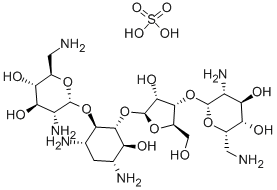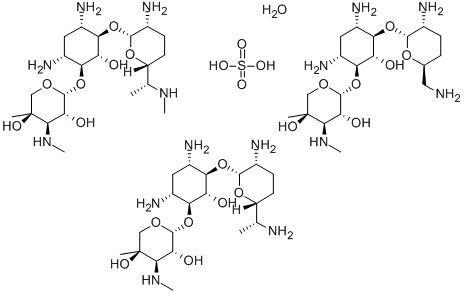Neomycin sulfate
Synonym(s):Neomycin sulfate;Neomycin Sulfate - CAS 1405-10-3 - Calbiochem;Neomycin Sulfate, γ-Irradiated, Tissue Culture Grade - CAS 1405-10-3 - Calbiochem;Neomycin sulphate;Neomycin trisulfate salt
- CAS NO.:1405-10-3
- Empirical Formula: C23H48N6O17S
- Molecular Weight: 712.72
- MDL number: MFCD00037007
- EINECS: 215-773-1
- SAFETY DATA SHEET (SDS)
- Update Date: 2025-12-26 12:07:08

What is Neomycin sulfate?
Description
Neomycin sulfate is an aminoglycoside antibiotic and calcium channel protein inhibitor. Neomycin sulfate also binds to prokaryotic ribosomes inhibiting translation and is effective against gram-positive and gram-negative bacteria. Neomycin sulfate inhibits PLC (Phospholipase C) via binding to inositol phospholipids. It also inhibits phosphatidylcholine-PLD activity and induces Ca2+ mobilization and PLA2 activation in human platelets. Neomycin sulfate inhibits DNase I induced DNA degradation. It is used to prevent or treat skin infections caused by bacteria. It is not effective against fungal or viral infections.
Chemical properties
White or yellowish-white powder; odorless; highly hygroscopic; aqueous solution exhibits dextrorotation. High solubility in water, while almost insoluble in ethanol, ether, acetone or chloroform.
Description
Neomycin sulfate is the most common form for pharmaceutical preparations.It as monotherapy is available in an oral solution for adjunct use in the treatment of hepatic coma. It is also used in combination with polymyxin B sulfates and hydrocortisone in otic suspensions for use in the treatment of bacterial infections in the external auditory canal, including infections caused by medical procedures in the ear.
The Uses of Neomycin sulfate
NEOMYCIN SULFATE is an aminoglycoside antibiotic found in many topical medications. NEOMYCIN SULFATE has been used as a preventive measure for hepatic encephalopathy and hypercholesterolemia.
The Uses of Neomycin sulfate
Neomycin sulfate is an aminoglycoside antibiotic produced by S. fradiae that inhibits protein translation by binding to the small subunit of prokaryotic ribosomes. It blocks voltage-sensitive Ca2+ channels and is a potent inhibitor of skeletal muscle sarcoplasmic reticulum Ca2+ release. NEOMYCIN SULFATE has been shown to inhibit inositol phospholipid turnover, phospholipase C, and phosphatidylcholine-phospholipase D activity (IC50 = 65 μM). It is highly effective against Gram-positive and Gram-negative bacteria and is commonly used for the prevention of bacterial contamination of cell cultures.
The Uses of Neomycin sulfate
Neomycin Sulfate[1405-10-3] is a powerful antibiotic that effectively treats skin, eye, and outer ear infections caused by most bacteria. It is also used in bowel surgery to prevent infection. Neomycin Sulfate has been utilized as a preventive treatment for hepatic encephalopathy and hypercholesterolemia.
Indications
This drug is obtained from species of the actinomycete Streptomyces and is an aminoglycoside antibiotic (as are streptomycin, gentamicin, and kanamycin) effective against most aerobic gram-negative organisms. Group A streptococci are relatively resistant. Neomycin acts to inhibit bacterial protein synthesis by irreversibly binding to the 30S subunit. It is responsible for a greater incidence of allergic contact sensitivity than any other topical antibiotic. This diagnosis often remains hidden, because morphologically the eruption is of a mild eczematous nature. Rarely, anaphylaxis may occur.
Definition
ChEBI: Neomycin B sulfate is the aminoglycoside sulfate salt that is the sulfate salt of neomycin B; a component of neomycin sulfate. It contains a framycetin.
brand name
Mycifradin (Pharmacia & Upjohn); Neo-Fradin (X Gen); Neobiotic (Pfizer);Abilene;Akentect;Amcort;Amphocort;Antibitulle;Apokalin;Aurex;Auriod;Baneopol;Barriere-mycin;Bastu-angin;Bedermin 100;Bio hubber;Biodry;Biofradin;Biofur;Biosol-m;Bio-vitastrept;Bivacyn;Bykanula;Canaural;Canoral;Cebemyxine;Cefrocyn;Cg 3224;Cicatrex;Cleniderm;Conderm;Conjuctilone;Cornemin;Cortinen;Damapo;Davimycin;Degramycin;Derbitan antibiotico;Dermicema;Dermo sonerge;Dermoface;Dermosan;Dermovate-nn;Derobion;Dexaamisolone-n;Dexabiotan;Dexacidin;Dexamist;Dexavetaderm;Dia-ject;Diarest;Dienterol;Dimicina;Doreplaston/doser/f;Dorithicin;Dulcicortine;Duphacerate;Dv 201;Emcortina;Emorex k berna;Enbacin;Enteromac;Enteropast;Enterosintex;Eustoporin;Febrizene;Fissan;Fl 6321 n;Flogocid;Fml-neo-liquifilm;Foille;Forbesotic;Formula 888;Forticillin;Fradyl;Frakidex;Frakitacine;Gastromycin;Gregoderm;Gustibon;H plus n;Hagrosept;Halicomb;Heliomycort;Hydrocortiderm;Hydro-neo oculos;I-caps;Idepa;Ido-op;Intradermo caf;Iodentero0neomicina;Itro;Jenomycin;Kaomycin;Kaopectate n;Kortikiod mepha;Lanbiotic;Larmicin;Latodurin;Linitut;Mammanopen;Mastrinal;Medisec neo;Medisec-cloxa;Medri-biotic;Meimyd;Menaderm antiacne;Mycerin;Mycidex;Mycimist;Mycipo;Mytrex;Nasomixin;Naso-neomicin;Nasydrin;Nefluan;Neimicina roger;Neo decaderm;Neo-analsona;Neoaristovet;Neobacimyx-h;Neobicin;Neobristan;Neo-cantil;Neocidin;Neocillin;Neoclox;Neocones;Neodecasone;Neo-delta-cortef;Neofluid;Neo-hydro;Neointestin;Neomac;Neo-mantle;Neo-mastitar;Neomycane;Neo-myx;Neo-otosol-hc;Neopec;Neopenol;Neopt;Neo-remusin;Neostrep;Neosule;Nifuramicin;Nisocla;Nisoclyn;Nisodyn;Nodryl;Nokamycin;Noperil;Ophthlmycin;Optiprime opthcoat;Optisone;Oribiotic;Oterna;Oticair;Oto vitna;Otocortison;Oto-flunal;Otomycin;Oto-sinerbe;Panotile;Parkeole;Parkesteron;Pentalmicina;Pervet;Phytacorcin;Polemycin;Polybactrin-g;Polygynax;Poly-pred;Polyspecrin;Porcijec;Prednicidin;Prevotec;Propaderm-n;Pulveodil;Pyocidin hc;Renokab;Rino vitna;Rinofilax;Rinojet;Rovicine;Saleton;Salvacolina nn;Sanibiovit;Sanimix;Sanistress;Secantol;Septomixine forte;Silderm;Siquent neomycin;Sofan;Sorbitoxin;Spersapolymyxin dispersa;Steros-anal;S-thalmic;Stiedex;Sulfix-6;Super masticort;Super mastitare;Synalar polyvalent;Syralbina;Tampovagan;Tariston;Telestyl;Tiframild;Tobispray;Topitasico;Tresaderm;Tribiotic;Tri-bow;Tricilone;Tri-optics;Troc;Tweenal;Ubrocelan;Uniriod;Uro-beniktol;Uro-nebctin;Varicella-rit;V-cortanmycetine;Vetroyl;Vetsovate;Vista-methasone n;V-softa.
World Health Organization (WHO)
Neomycin sulfate, a broad-spectrum antibiotic, was first isolated in 1949 and has subsequently been included in topical, oral and parenteral preparations. Its value in the treatment of diarrhoea is widely questioned although it is still contained in a number of widely available antidiarrhoeal preparations. In some countries the officially approved indications for oral preparations are restricted to the preparation of the bowel prior to surgery and the management of hepatic coma.
General Description
Chemical structure: aminoglycoside
Contact allergens
Neomycin is an antibiotic complex of the aminoglycosides group, extracted from Streptomyces fradiae. It is composed of neomycin A (neamin) and an isomer neobiosamin, either neomycin B (framycetin or Soframycin?) or neomycin C. Its use has been progressively forbidden in cosmetics and as an additive for animal feed. Occupational contact dermatitis occurs in workers at animal feed mills, in veterinaries, or in health workers. Nonoccupational dermatitis mainly concerns patients with chronic dermatitis, leg ulcers, or chronic otitis. Cross-sensitivity is usual with other aminoglycosides (amikacin, arbekacin, butirosin, dibekacin, gentamicin, isepamicin, kanamycin, paromomycin, ribostamycin, sisomycin, tobramycin), is rare with netilmicin and streptomycin, but nonexistent with spectinomycin.
Biochem/physiol Actions
Neomycin Trisulfate is an aminoglycoside antibiotic, which is produced by Streptomyces containing a minimum of 85% neomycin B. It is used to study the cytotoxic side effects of antibiotics, platelet-derived growth factor responses in certain fibroblasts and extraction of nuclear phosphatidylinositol 4,5-bisphosphate-interacting proteins. Neomycin trisulfate functions as a selection agent for prokaryotic cells transformed using the neo selectable marker gene. This product is recommended for use in cell culture applications at 5 mL/L.
Clinical Use
In a search for antibiotics less toxic than streptomycin,Waksman and Lechevalier isolated neomycin (Mycifradin,Neobiotic) in 1949 from Streptomyces fradiae. Since then, theimportance of neomycin has increased steadily, and today, itis considered one of the most useful antibiotics for the treatmentof GI infections, dermatological infections, and acutebacterial peritonitis. Also, it is used in abdominal surgery toreduce or avoid complications caused by infections from bacterialflora of the bowel. It has broad-spectrum activityagainst various organisms and shows a low incidence of toxicand hypersensitivity reactions. It is absorbed very slightlyfrom the digestive tract, so its oral use ordinarily does not produce any systemic effect. The development of neomycinresistantstrains of pathogens is rarely reported in those organismsagainst which neomycin is effective.
Neomycin as the sulfate salt is a white to slightly yellow,crystalline powder that is very soluble in water. It is hygroscopicand photosensitive (but stable over a wide pH rangeand to autoclaving). Neomycin sulfate contains the equivalentof 60% of the free base.
Neomycin, as produced by S. fradiae, is a mixture ofclosely related substances. Included in the “neomycin complex”is neamine (originally designated neomycin A) andneomycins B and C. S. fradiae also elaborates another antibiotic,the fradicin, which has some antifungal propertiesbut no antibacterial activity. This substance is not present in“pure” neomycin.
Side Effects
Common side effects of neomycin sulfate include:
nausea,
vomiting, or
diarrhea.
Side Effects
The most common adverse reactions to oral neomycin sulfate are nausea, vomiting and diarrhea. The “Malabsorption Syndrome” characterized by increased fecal fat, decreased serum carotene and fall in xylose absorption has been reported with prolonged therapy.
Safety Profile
Poison by intramuscular, intravenous, and subcutaneous routes. Human systemic effects by ingestion: somnolence, hallucinations and distorted perceptions, and anorexia. A human skin irritant. When heated to decomposition it emits very toxic fumes of SOx.
Veterinary Drugs and Treatments
Because neomycin is more nephrotoxic and less effective against several bacterial species than either gentamicin or amikacin, its use is generally limited to topical formulations for skin, eyes, and ears, oral treatment of enteric infections, to reduce microbe numbers in the colon prior to colon surgery, and oral or enema administration to reduce ammonia-producing bacteria in the treatment of hepatic encephalopathy. Doses for parenteral administration are listed below, but should be used only with extreme caution due to the drug’s toxic potential.
Drug interactions
Potentially hazardous interactions with other drugs
Antibacterials: absorption of
phenoxymethylpenicillin reduced; increased risk of
nephrotoxicity with colistimethate or polymyxins
and possibly cephalosporins; increased risk of
ototoxicity and nephrotoxicity with capreomycin or
vancomycin.
Anticoagulants: altered INR with coumarins or
phenindione.
Ciclosporin: increased risk of nephrotoxicity.
Cytotoxics: possibly reduced methotrexate
absorption; bioavailability of sorafenib reduced;
increased risk of nephrotoxicity and possibly of
ototoxicity with platinum compounds.
Diuretics: increased risk of ototoxicity with loop
diuretics.
Muscle relaxants: enhanced effects of
suxamethonium and non-depolarising muscle
relaxants.
Parasympathomimetics: antagonism of effect of
neostigmine and pyridostigmine.
Tacrolimus: increased risk of nephrotoxicity
Metabolism
Only 3% of dose is absorbed. Approximately 97% of an oral dose is excreted unchanged in the faeces
Properties of Neomycin sulfate
| Melting point: | >187°C (dec.) |
| alpha | D20 +54° (c = 2 in H2O) |
| refractive index | 56 ° (C=10, H2O) |
| Flash point: | 56℃ |
| storage temp. | 2-8°C |
| solubility | H2O: 50 mg/mL As a stock solution. Stock solutions should be filter sterilized and stored at 2-8°C. Stable at 37°C for 5 days. |
| form | powder |
| color | white to slightly yellow |
| PH | 5.0-7.5 (50g/l, H2O, 20℃) |
| Water Solubility | Soluble in water |
| Merck | 14,6454 |
| Stability: | Stable. Incompatible with strong oxidizing agents. |
| CAS DataBase Reference | 1405-10-3(CAS DataBase Reference) |
| EPA Substance Registry System | Neomycin sulfate (1405-10-3) |
Safety information for Neomycin sulfate
| Signal word | Danger |
| Pictogram(s) |
 Health Hazard GHS08 |
| GHS Hazard Statements |
H317:Sensitisation, Skin H334:Sensitisation, respiratory |
| Precautionary Statement Codes |
P261:Avoid breathing dust/fume/gas/mist/vapours/spray. P280:Wear protective gloves/protective clothing/eye protection/face protection. P342+P311:IF experiencing respiratory symptoms: call a POISON CENTER or doctor/physician. |
Computed Descriptors for Neomycin sulfate
| InChIKey | OIXVKQDWLFHVGR-VTSVPHRWSA-N |
Neomycin sulfate manufacturer
New Products
4,4-Difluoropiperidine hydrochloride tert-butyl 9-methoxy-3-azaspiro[5.5]undecane-3-carboxylate Indole Methyl Resin N-Isopropylurea N,N-Dicyclohexylcarbodiimide(DCC) MELDRUMS ACID 5-METHYLISOXAZOLE-4-CARBOXYLIC ACID Magnessium Bis glycinate Zinc ascorbate 1-bromo-2-butyne 2-acetamidophenol 9(10H)-anthracenone Erythrosin B, 4-Piperidinopiperidine 2-((4-morpholinophenylamino) (methylthio) methylene) malononitrile 2,4-dihydroxybenzaldehyde 3-(4-morpholinophenylamino)-5-amino-1H-pyrazole-4-carbonitrile Methyl 2-methylquinoline-6-carboxylate 2,6-dichloro-4-nitropyridine 4-Bromo-2-chlorobenzonitrile 2-(benzylamino)acetic acid hydrochloride 4-(tert-Butoxycarbonylamino)but- 2-ynoic acid 3,4-dihydro-2H-benzo[b][1,4]dioxepine 1-Phenyl-1-cycloprppanecarboxylicacidRelated products of tetrahydrofuran

![(E)-N-[4-[N-(3-Methoxypyrazin-2-yl)sulfaMoyl]phenyl]-3-(5-nitrothiophene-2-yl)acrylaMide](https://img.chemicalbook.in/CAS/GIF/432531-71-0.gif)

![NEOMYCIN B, SULPHATE, [3H]-](https://img.chemicalbook.in/)




You may like
-
 Neomycin Sulphate 99%View Details
Neomycin Sulphate 99%View Details -
 Neomycin Sulphate (NMS) for cell culture CAS 1405-10-3View Details
Neomycin Sulphate (NMS) for cell culture CAS 1405-10-3View Details
1405-10-3 -
 Neomycin sulphate CAS 1405-10-3View Details
Neomycin sulphate CAS 1405-10-3View Details
1405-10-3 -
 Fradiomycin Sulfate CAS 1405-10-3View Details
Fradiomycin Sulfate CAS 1405-10-3View Details
1405-10-3 -
 Neomycin sulfate CAS 1405-10-3View Details
Neomycin sulfate CAS 1405-10-3View Details
1405-10-3 -
 Neomycin sulfate 600IU/mg CAS 1405-10-3View Details
Neomycin sulfate 600IU/mg CAS 1405-10-3View Details
1405-10-3 -
 NEOMYCIN SULPHATE For Bacteriology CAS 1405-10-3View Details
NEOMYCIN SULPHATE For Bacteriology CAS 1405-10-3View Details
1405-10-3 -
 Neomycin trisulfate salt hydrate CAS 1405-10-3View Details
Neomycin trisulfate salt hydrate CAS 1405-10-3View Details
1405-10-3
